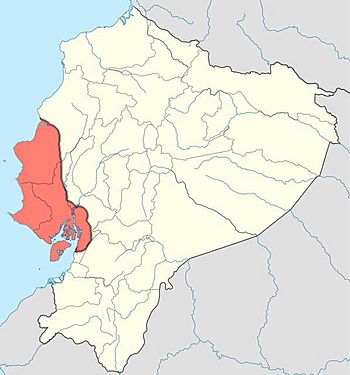Manteño-Huancavilca civilization facts for kids
Quick facts for kids
Manteño
|
|||||||||
|---|---|---|---|---|---|---|---|---|---|
| c. 600–1530 | |||||||||

A map of the Manteno civilization (red) within Ecuador (yellow). The eastern boundary was complex (not shown)
|
|||||||||
| Capital | Manta | ||||||||
| Historical era | Integration | ||||||||
|
• Established
|
c. 600 | ||||||||
|
• Disestablished
|
1530 | ||||||||
|
|||||||||
The Manteño-Huancavilca civilization (called Los Manteños in Spanish) was an important group of people in what is now Ecuador. They lived there long ago, before Christopher Columbus arrived. This civilization was active from about 850 to 1600 CE. They built their homes in the same area where the older Valdivia culture once lived.
Contents
Who Were the Manteño People?
The name "Manteño" was first used in the mid-1900s. An Ecuadorian archeologist named Jacinto Jijón y Caamaño came up with the term. He used it to describe ancient settlements near the city of Manta on the Pacific coast.
Different Manteño Groups
Soon after, the term "Manteño" started to be used for several different groups. These included the northern Manteño, southern Manteño (also called Huancavilca), and Punáe. Some experts, though, prefer to call all these groups "Huancavilca." This name comes from the Incan people.
Historian Cieza de León noted differences between coastal towns. For example, people north of Salango had different facial tattoos. Experts also think there might have been differences between people living near the coast and those living inland.
Where Did They Live?
The Manteño chiefdoms (or groups led by chiefs) lived along the coast. Their territory covered parts of the provinces of Manabí, Santa Elena, and Guayas. This area also included La Plata Island.
The Bahía de Caráquez and Chone River were the northern border of their land. The Guayas river basin marked their southern border. Important Manteño sites have been found in places like Picoazá, Cerro de Hojas, Cerro Jaboncillo, and Agua Blanca.
How Were They Organized?
Many Manteño groups were divided into four main settlements. The chief of the most important settlement was in charge of the others. Some historians believe the Manteños worked more like a trading network than a kingdom. They traded goods with other groups. Manteño settlements often have lots of special pottery and large stone foundations.
What Was Their Daily Life Like?
The Manteño people were skilled farmers. They grew many fruits and vegetables. Their main crops included maize (corn), peanuts, tomatoes, and squash.
Homes and Buildings
They built their houses using natural materials. Some homes were made of straw or palm leaves. Others used a type of bamboo that grew in the region. They often used river rocks to create strong foundations for their houses.
The Special Spondylus Shell
The Manteño culture was very good at diving for Spondylus shells. These shells came from a type of clam. The Manteños believed this food was a gift from the gods. They also used the beautiful purple and orange shells as a type of money.
These shells were traded far and wide, even as far north as Mexico. The Spondylus clam only lives in the warm waters off the coast of Ecuador. The Manteños were so unique and skilled at finding these shells that the Inca Empire never conquered them. Instead, the Manteños were able to trade their special food and shells with the Inca.
See also
 In Spanish: Cultura Huancavilca para niños
In Spanish: Cultura Huancavilca para niños

